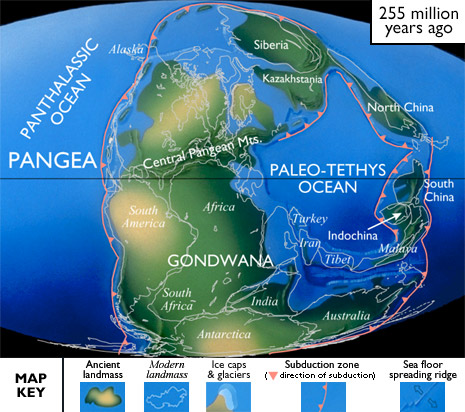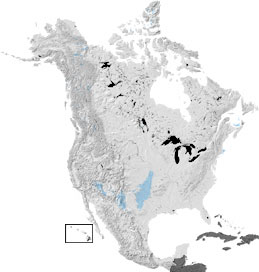the Permian - 290 to 248 Million Years Ago
|
|
|
World Paleogeography: Around the world, the continental collisions begun in the Carboniferous continued into the Permian. These collisions assembled western Pangea and surrounded it with subduction zones. Eastern Pangea would not form until the Triassic, but the terranes that would comprise it were moving and assembling in the Paleo-Tethys Ocean. These small landmasses included the Cathaysian terranes (North China, South China, and other pieces of Southeast Asia) and the Cimmerian terranes, or Cimmeria (Turkey, Iran, Tibet, and other pieces of Central Asia). The formation of Pangea closed smaller seas between continents and uplifted mountain ranges around the supercontinent. Computer models of climate during the Permian indicate that these conditions, coupled with a large continental interior, generated a dry climate with great seasonal fluctuations. North American Paleogeography: As Pangea was assembled, most of North America was being uplifted during the Permian. This uplift generated the famous fold belts of the Appalachian Mountains and exposed more land in present-day central North America. Shallow seas covered much of modern western North America. Large reef complexes developed and extensive evaporite deposits formed in restricted lagoons at the shoreline. Farther west, subduction began, generating volcanic activity in the region of the modern Sierra Nevada. Paleontology: The Permian Period marks the end of the Paleozoic Era and the time of the largest mass extinction in Earth’s history. This extinction event affected many different environments, but it affected marine communities the most by far. It has been estimated that nearly 90% of all species became extinct at the end of the Permian. Gone were the trilobites, rugose and tabulate corals, and many species of brachiopods, molluscs, and echinoderms. As the climate became drier, the vast swamps of the Carboniferous disappeared and were replaced by forests more tolerant of dry conditions. Modern conifers first appeared in the fossil record of the Permian. |
|
 |
See the Permian in:
Or jump to another period:
|
|
Links to more about the Permian
|
Research and Collections | Organizations | Education and Exhibits | Research and Collections | Resources
Research and Collections
(showing 1 of 1 listings)
The Natural History Museum, London's conodont collection: This database gives broad information about discrete collections within the conodont collection housed at the NHM. Generic, specific and subspecific names are included in the database, but the data is being updated regularly. As a result, the database is best searched by name of donor/collector/publisher or by geological period. Links to images are included with some collections.
 Top of List Top of List
Organizations
Museums (showing 2 of 2 listings)
Alabama Museum of Natural History: Collections: Experience the natural diversity of Alabama through exhibits from the Age of Dinosaurs, the Coal Age, and the Ice Age. View the Alabama Museum of Natural History's extensive collections of geology, zoology, mineralogy, paleontology, ethnology, history, and photography. Located in historic Smith Hall on the University of Alabama campus, the Museum's mission is to broaden the knowledge of natural sciences and human culture through collections and quality programs of research, instruction, and service; many family-friendly events are offered.
Garvies Point Museum official website: Garvies Point Museum and Preserve is located on Long Island's north shore in New York State. We are a center for regional geology research. Our exhibits deal with regional (Long Island and New York State) geology, fossilization and minerology and the ehnography and archaeology of northeastern Native Americans. Our exhibit "Drifitng Lands and Ancient Seas" details the geology of New York State coordinated with plate tectonics. 
 Top of List Top of List
Education and Exhibits
Virtual Exhibits (showing 3 of 4 listings)
Ancient Denvers: Ancient Denvers is a virtual exhibit that highlights 13 reconstructions of ancient Colorado landscapes.
Virtual Museum of Fossils: Geosciences, at Georgia's Valdosta State University, presents an interactive virtual museum of invertebrate and vertebrate fossil specimens. Explore the collection by animal, or by time period from Precambrian to Quaternary. Maps are detailed and include ecosystem distribution. Fossil photographs, many showing multiple views, list information about where the fossil was found, and how it is categorized taxonomically. Some pages feature a drawing of the animal's skeleton showing the fossil bone in red.
The Third Planet - a walk through geologic time: This virtual exhibit offers a tour of the Milwaukee Public Museum's geology exhibits, depicting the continuing evolution of the Earth from the Precambrian to present.
 More Virtual Exhibits More Virtual Exhibits
 Top of List Top of List
Research and Collections
Researchers (showing 3 of 4 listings)
University of Kansas Paleobotanical Collection: Collection of fossil plants currently housed at the University of Kansas.
Dr. Thomas W. Kammer: Specialty: Evolutionary paleoecology of Paleozoic crinoids, plus lithostratigraphy, biostratigraphy, and sequence stratigraphy of marine Mississippian rocks in the east-central United States. Field areas include West Virginia, Kentucky, Indiana, Illinois, Missouri, and Iowa.
Gigantopterids and Early Angiosperms: Detailed information about the study of the origin of flowering plants.
 More Researchers More Researchers
 Top of List Top of List
Ongoing Research Projects (showing 2 of 2 listings)
Sam Noble Oklahoma Museum of Natural History: On the campus of the University of Oklahoma in Norman. One of the finest university-based museums in the nation, with an active Paleontology research program and extensive collections. 
Vertebrate Paleontology Laboratory, UT: The University of Texas Vertebrate Paleontology Laboratory houses one of the 10 largest collections in North America, and it supports one of the Nation's largest graduate education programs in paleontology. It also supports public exhibits at the Texas Memorial Museum.
 Top of List Top of List
Resources
Courses and Lectures (showing 1 of 1 listings)
Paleogeography of the Southwestern U.S.: The paleogeography of the southwestern U.S. from 1.8 billion years ago to 10 million years ago. Text and images by Dr. Ron Blakey from Northern Arizona University.
 Top of List Top of List
Field Guides (showing 1 of 1 listings)
Fossil Cephalopods in Utah: A reference to help provide information on the identity, biostratigraphy and location of fossil cephalopods found in the state of Utah.
 Top of List Top of List
Databases (showing 3 of 3 listings)
New Mexico Museum of Natural History and Science Web-based Paleo-database Home Page: Search the fossil collections of the New Mexico Museum of Natural History and Science. Listings by Kingdom down to species, era, epoch, group, formation, country, New Mexico county, and map ID. Many listings contain images of the fossils (including all holotypes.) 
The Paleointegration Project: The PaleoIntegration Project (PIP) is facilitating interoperability between global-scale fossil and sedimentary rock databases (e.g. The Paleobiology Database and the Paleogeographic Atlas Project), enabling a greater understanding of the life, geography and climate of our planet throughout the Phanerozoic. Databases can be searched via text and interactive maps, and by any combination of age, location, or content. Results can be plotted on present- and paleo- maps or downloaded for detailed analyses.
Stratigraphy.net: Stratigraphy.Net aims to provide free and open access to geoscientific information and data with special emphasis on the disciplines stratigraphy, paleontology and sedimentology.
 Top of List Top of List
Annotated Bibliographies (showing 1 of 1 listings)
Bibliography of Paleobotany: A bibliographic database of paleobotany including more than 56,000 entries. It also includes references on Antarctic geology and paleontology and citations on Women in Science.
 Top of List Top of List
Maps (showing 1 of 1 listings)
Paleogeography and Geologic Evolution of North America: The images presented here show the paleogeography of North America over the last 550 million years of geologic history.
 Top of List Top of List
General Reference (showing 3 of 5 listings)
Fossil Permian Plants from Puebla, Mexico: A discussion of fossil plants from the Matzitzi Formation with good photographs.
Fossils In Death Valley National Park: The paleontology, geology and natural wonders of Death Valley National Park (and more); many images of fossils; field trips; paleontology links, plus links to Death Valley.
List of Dinosaurs: This dinosaur listing is data-packed and can be sorted by dinosaur length, weight, time period, etc.
 More General Reference More General Reference
 Top of List Top of List
|
|



